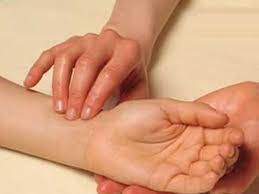Pulse is an expression of physiology’s functioning in general and an indicator of somatic and mental health. According to Ayurveda, every cell of our body sends its own, unique signals to the heart via the bloodstream. These separate signals gather together into a single ‘frequency carrier’, pulse, thus decrypting and updating the state of our body.
The pulse helps determine how energy circulates within the body, obtain information about disease-affected organs, correctly select a treatment method and assess its results. Pulse measurement is a natural procedure that creates, in a matter of minutes, a whole diagram of the performance of our body in general and every organ in particular.
A substantial advantage of pulse diagnostics is that it helps detect the origins of a disease even before any external or internal symptoms will begin to manifest themselves when only disturbance of harmony in circulation of energy within the body is visible.
Diet plans and treatments are made in line with the Doshas or vital energies in Ayurveda. In order to detect whether your dominant Dosha is Kapha, Pitta, Vata, or a mixture, we will perform a Nadi Vigyan- Ayurvedic diagnosis. The details collected from the Ayurvedic pulse examination offer the foundation for your in-depth medication approach at the Ayurveda Resort Mandira. Analyzing your pulse is a section of the tailored consultation that helps us determine the most appropriate Ayurvedic medication for you.
What happens during the Ayurvedic Pulse Examination?
During the Nadi Vigyan, one of our specialists will place a ring, middle and index finger on the hollow under the wrist and track the pulse's features beneath every finger. Pitta Dosha can be felt beneath the middle finger, Kapha Dosha beneath the ring finger, and the Vata Dosha beneath the index finger.
 The doctor carefully tracks the behavior of the pulse beneath every finger and utilizes the following pairs of features to explain it:
The doctor carefully tracks the behavior of the pulse beneath every finger and utilizes the following pairs of features to explain it:
• Smooth or rough
• Viscous or thin
• Strong or subtle
• Faint or clear
• Moving or stable
• Soft or hard
• Oily or dry
• Quick or slow
• Light or heavy
• Cold or hot
The behavior of the pulse identified beneath the three fingers will allow the doctor to determine your type of constitutional. Many individuals fall into two or one type categories and thus have an inequity that leads to some degree of illness. If the three forces are stable, the Vata pulse ought to feel rough, thin, strong, clear, moving, hard, dry, light, and cold. This is often matched to the slithering motion of a snake.
The features of a stable Kapha pulse may often feel viscous, slow, subtle, faint, and regular. On the other hand, a stable Pitta pulse may feel dynamic, oily, quick, and regular, and hot- which can be compared with a hopping frog. It is the same as a swan gliding on water.
Our specialists also track other symptoms and signs that offer more information about the metabolic stumbling blocks. They will ask you about digestion and diet, lifestyle, and sleet to help them design a holistic image of your constitution.
The full information comes together to create the foundation of your treatment strategy, which includes complimentary healing methods and a nutrition program. We also offer multiple tips to help you work on your well-being.
Different levels of the pulse
Your pulse has more information about your spiritual well-being than you may think. In a well-detailed Ayurvedic pulse examination, the specialist can now draw precise conclusions about the whole record of the patient, from the start of their life to their current health status.
Physical diagnosis through the pulse also allows the specialist to observe the patient's healing progress, even though there are no signs of improvement. Essentially, pulse examination is the most critical for the early determination of conditions, including those that are beginning to show up. This makes it easier to prevent ailments before they become more pronounced.
 Stages of disease formation
Stages of disease formation
Disease formation has six stages, including:
I. Accumulation (Sanchaya): in this stage, the blockage is just starting to develop, though it is already straining the Subdoshas level and their related organs.
II. Aggravation (Parkopa): this leads to congestion which intensifies the imbalance.
III. Spread (Prasara): at this stage, the Dosha attempts to get a path around the blockage and spreads to the Subdoshas and throughout the body.
IV. Localization (Sthana Samshraya): while the Dosha spreads throughout the body, it can form in the wrong parts. You may experience the first symptoms of the disease here.
V. Manifestation (Vyaki): here, the inequity has developed to the degree that the signs can be observed.
VI. Outbreak (Bheda): spirit, body, and mind are thrown totally off balance, and the disease is entirely noticeable.
To ensure that things do not get that far, our pulse examination detects known accumulations, offering us a chance to treat them, so that balance and strength can be restored and signs eliminated as early as possible.
Get Started With a Free 15-Minute Consultation
Our Reviews
"Knowledge of Ayurveda made my life harmonious and full-fledged. For over 10 years I was trying to recover the women’s health and dreamed about having a child. Traditional treatment methods could not help me. I was lucky to meet Tetiana . In just 1.5 years, Ayurveda became my lifestyle, and very soon, I have received my long-awaited gift – a son."
A.C. -- Ft. Lauderdale, FL
